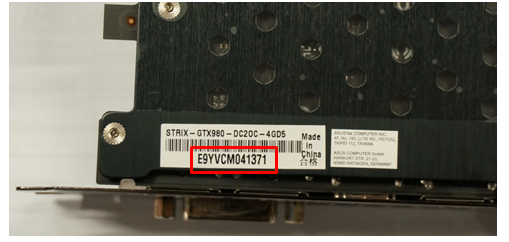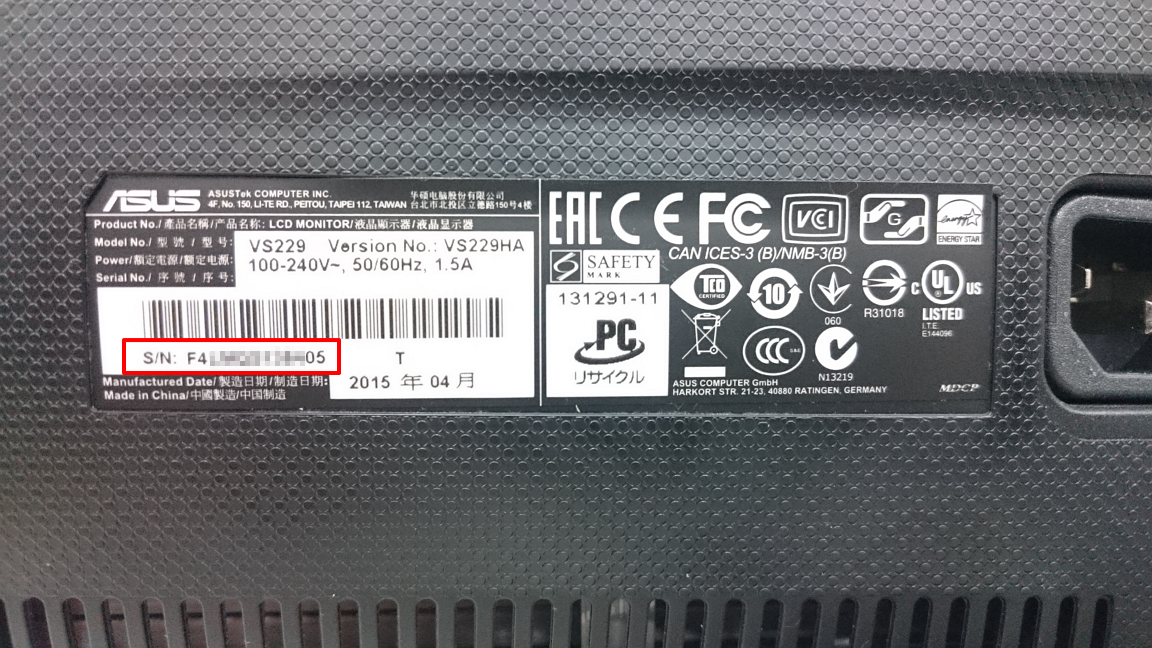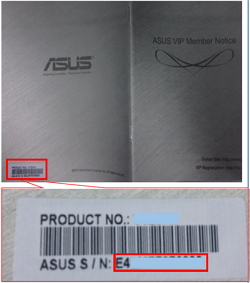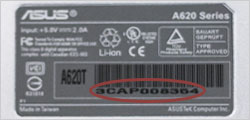| Brand Name of the company-manufacturer. | Asus |
| Model Designation of the model. | VG245H |
| Model year The year in which this model was announced. | 2016 |
- Asus Specs By Serial Number Free
- Imac Specs By Serial Number
- Asus Specs By Serial Number Identification
- Asus Specs By Serial Number Location
- The maximum number of colors, which the display is able to reproduce, depends on the type of the panel in use and color enhancing technologies like FRC. Colors 30 bits: Aspect ratio. The ratio between the horizontal and the vertical side of the display. Some of the standard and widely used aspect ratios are 4:3, 5:4, 16:9 and 16:10.
- Asus Z170-P Full Specifications: Width: 305, Depth: 224, Audio codec: Realtek ALC887, Audio output channels: 7.1, Supported memory bus.
- ASUS Q536FD BI7T15 - 15.6' - Core i7 8565U - 16 GB RAM - 256 GB SSD + 2 TB HDD overview and full product specs on CNET.
Display
Information about the main characteristics of the display - panel, backlight, resolution, refresh rate, etc.
Look up information based on Serial Number / SNID / Service Tag / IMEI. Info@SNLookup.com $ 0.00 0.00. Check the Serial Number data field in the BIOS Main menu. To get into BIOS menu, press F2 button repeatedly after powering up until BIOS menu shows up. Check the sticker label on the side of the package box. The serial number is listed after the word “Serial Number,” “SSN,” “S/N,” or “SN.”.
| Size class Size class of the display as declared by the manufacturer. Often this is the rounded value of the actual size of the diagonal in inches. | 24 in (inches) |
| Diagonal Approximate diagonal size of the display. If the manufacturer does not provide such information, the diagonal is calculated from the width and height of the screen. | 609.7 mm (millimeters) 60.97 cm (centimeters) 24.0039 in (inches) 2.0003 ft (feet) |
| Width Approximate width of the display. If the manufacturer does not provide such information, the width is calculated from the diagonal and the aspect ratio. | 531.36 mm (millimeters) 53.136 cm (centimeters) 20.9197 in (inches) 1.7433 ft (feet) |
| Height Approximate height of the display. If the manufacturer does not provide such information, the height is calculated from the diagonal and the aspect ratio. | 298.89 mm (millimeters) 29.889 cm (centimeters) 11.7673 in (inches) 0.9806 ft (feet) |
| Panel type There are various panel technologies. Each has its own specific features - viewing angles, color reproduction, response time, brightness/contrast, production cost, etc. The image quality depends directly on the type of the display panel used. | TN |
| Panel bit depth The most widely used panels are those with 6, 8, and 10 bits for each of the RGB components of the pixel. They provide 18-, 24-, and 30-bit color, respectively. | 8 bits |
| Colors The maximum number of colors, which the display is able to reproduce, depends on the type of the panel in use and color enhancing technologies like FRC. | 16777216 colors 24 bits |
| Aspect ratio The ratio between the horizontal and the vertical side of the display. Some of the standard and widely used aspect ratios are 4:3, 5:4, 16:9 and 16:10. | 1.778:1 16:9 |
| Resolution Information about the number of pixels on the horizontal and vertical side of the screen. A higher resolution allows the display of a more detailed and of higher quality image. | 1920 x 1080 pixels Full HD / 1080p |
| Pixel pitch The pixel pitch shows the distance from the centers of two neighboring pixels. In displays, which have a native resolution (the TFT ones, for example), the pixel pitch depends on the resolution and the size of the screen. | 0.277 mm (millimeters) 0.0277 cm (centimeters) 0.0109 in (inches) 0.0009 ft (feet) |
| Pixel density Information of the number of pixels in a unit of length. With the decrease of the display size and the increase of its resolution, the pixel density increases. | 91 ppi (pixels per inch) 36 ppcm (pixels per centimeter) |
| Display area The percentage of the approximate area, taken by the active part of the screen, to the total front area. | 86.05 % (percent) |
| Backlight The backlight is the source of light of the LCD display panels. The type of backlight determines the image quality and the color space of the display. There are various backlights such as CCFL, LED, WLED, RGB-LED, and etc. | W-LED |
| sRGB sRGB is a color space, developed jointly by Hewlett-Packard and Microsoft in 1996. It is used in different devices such as printers, displays, TV sets, cameras, etc. The sRGB color space covers about 72% of the NTSC color space. | 95 % (percent) |
| Adobe RGB (1998) Adobe RGB (1998) is a color space, developed by Adobe Systems in 1998. It has a wider gamut than the sRGB (mainly in the cyan-green range of colors) and is widely used in professional printing. | 70 % (percent) |
| NTSC (1953) The NTSC (1953) color space is introduced in 1953 by the FCC with the appearance of color television and has a wider gamut than the sRGB. | 72 % (percent) |
| Brightness Information about the brightness of the screen. It is measured in candela per square metre (cd/m²). | 250 cd/m² (candela per square meter) |
| Static contrast The static contrast shows the ratio between the brightest and the darkest color, which the display can reproduce simultaneously, for example, within one and the same frame/scene. | 1000 : 1 |
| Dynamic contrast The dynamic contrast shows the ratio between the brightest and the darkest color, which the display can reproduce over time, for example, in the course of playing a video. | 100000000 : 1 |
| Horizontal viewing angle Information about the maximum horizontal viewing angle, within which the image on the screen is of acceptable quality. | 170 ° (degrees) |
| Vertical viewing angle Information about the maximum vertical viewing angle, within which the image on the screen is of acceptable quality. | 160 ° (degrees) |
| Minimum response time Information about the minimum amount of time, in which the pixels change from one color to another. Very often the manufacturer provides the response time for transition from grey-to-grey (G2G). | 1 ms (milliseconds) 0.0010 s (seconds) |
| Average response time Information about the average amount of time, in which the pixels change from one color to another. | 5 ms (milliseconds) 0.0050 s (seconds) |
| Maximum response time Information about the maximum amount of time, in which the pixels change from one color to another. | 15 ms (milliseconds) 0.0150 s (seconds) |
| Input lag Desktop monitors and smart TVs experience a latency/lag in visualizing the information. The time in milliseconds that the display needs to visualize the signal input. | 7 ms (milliseconds) 0.0070 s (seconds) |
| Coating Information about the type of coating of the display. There are different types of matte and glossy coatings, each of which has its own advantages and drawbacks. | Anti-glare/Matte |
| 3D Information on whether 3D is supported or not. | No |
Frequencies
Information about the horizontal and vertical refresh rates/frequencies.
| Horizontal frequency (digital) The horizontal scan rate/frequency shows the number of horizontal lines, displayed by the monitor per second, when it is plugged to a digital source. | 31.5 kHz - 84 kHz (kilohertz) |
| Vertical frequency (digital) The vertical frequency/refresh rate shows how many times in a second the image on the screen is refreshed. | 56 Hz - 75 Hz (hertz) |
| 110V Permissible voltage tolerance in a 110-volt electric system. | 100 V - 120 V (volts) |
| 220V Permissible voltage tolerance in a 220-volt electric system. | 220 V - 240 V (volts) |
| Alternating current frequency Requirement regarding the alternating current frequency in the electric system. | 50 Hz - 60 Hz (hertz) |
| Power consumption (off) Power consumption in off-mode. | 0.5 W (watts) |
| Power consumption (sleep) Power consumption in sleep/stand by/suspend mode. | 0.5 W (watts) |
| Power consumption (eco) Average power consumption in economy mode. | 16.18 W (watts) |
Dimensions, weight and color
Information about the dimensions and the weight of the specific model with and without stand as well as the colors, in which it is offered to the market.
| Width Width without stand in different measurement units. | 561 mm (millimeters) 56.1 cm (centimeters) 22.0866 in (inches) 1.8406 ft (feet) |
| Height Height without stand in different measurement units. | 329 mm (millimeters) 32.9 cm (centimeters) 12.9528 in (inches) 1.0794 ft (feet) |
| Depth Depth without stand in different measurement units. | 50 mm (millimeters) 5 cm (centimeters) 1.9685 in (inches) 0.164 ft (feet) |
| Width with stand Width with stand in different measurement units. | 561 mm (millimeters) 56.1 cm (centimeters) 22.0866 in (inches) 1.8406 ft (feet) |
| Height with stand Height with stand in different measurement units. | 359 mm (millimeters) 35.9 cm (centimeters) 14.1339 in (inches) 1.1778 ft (feet) |
| Depth with stand Depth with stand in different measurement units. | 211 mm (millimeters) 21.1 cm (centimeters) 8.3071 in (inches) 0.6923 ft (feet) |
| Weight with stand Weight with stand in different measurement units. | 5.1 kg (kilograms) 11.24 lbs (pounds) |
| Box width Width of the package in different measurement units. | 664 mm (millimeters) 66.4 cm (centimeters) 26.1417 in (inches) 2.1785 ft (feet) |
| Box height Height of the package in different measurement units. | 415 mm (millimeters) 41.5 cm (centimeters) 16.3386 in (inches) 1.3615 ft (feet) |
| Box depth Depth of the package in different measurement units. | 221 mm (millimeters) 22.1 cm (centimeters) 8.7008 in (inches) 0.7251 ft (feet) |
| Box weight Weight of the product with all accessories and packaging in different measurement units. | 7.4 kg (kilograms) 16.31 lbs (pounds) |
| Colors Information about the colors, in which the specific model is offered to the market. | Black |
| VESA mount Information about whether there is a possibility for wall mounting according to the VESA Mounting Interface Standard (MIS). | Yes |
| VESA interface There are many various interfaces under the VESA standard, which differ in the size of the brackets, the distances between the screw holes and their number. | 100 x 100 mm |
| Removable stand Information about whether the stand can be dismounted. Usually, this is required for wall mounting. | Yes |
| Height adjustment Information about whether the stand allows height adjustment. | Yes |
| Height adjustment range Information about the extent to which the stand allows the height to be adjusted. | 130 mm (millimeters) 13 cm (centimeters) 5.1181 in (inches) 0.4265 ft (feet) |
| Landscape/portrait pivot Some displays have the ability to operate in landscape and portrait mode alike. | Yes |
| Left pivot Degree of pivoting the display counterclockwise. | 90 ° (degrees) |
| Right pivot Degree of pivoting the display clockwise. | 90 ° (degrees) |
| Left/right swivel Information whether the display can be swiveled around the stand axis. | Yes |
| Left swivel Maximum swivel degree of the display to the left of the stand axis. | 90 ° (degrees) |
| Right swivel Maximum swivel degree of the display to the right of the stand axis. | 90 ° (degrees) |
| Forward/backward tilt Most displays have the ability to be tilted forward and backward as to provide a more comfortable viewing position for the user. | Yes |
| Forward tilt Maximum degree of forward tilting of the display. | 5 ° (degrees) |
| Backward tilt Maximum degree of backward tilting of the display. | 33 ° (degrees) |
Audio


Information about the audio system - number and power of the built-in speakers, supported audio technologies.
| Speakers The speaker is a device, which converts electrical audio signals into acoustic vibrations resulting in corresponding sounds. | 2 x 2 W (watts) |
| Camera Information whether the current model has a built-in camera or not. | No |
Asus Specs By Serial Number Free
Connectivity
Available connectivity ports, slots and interfaces.
| Connectivity Information about the available connectivity ports, slots and interfaces such as USB, infrared port, SD card slot, audio/video and network interfaces, etc. | 2 x HDMI 1.4 1 x D-sub 1 x 3.5 mm Audio In 1 x 3.5 mm Audio Out |
| High-bandwidth Digital Content Protection (HDCP) |


| Features Information about additional software features, technologies, functions and services of the model. | 5-way OSD joystick AMD FreeSync technology Flicker-free technology GamePlus (Crosshair/Timer) GameVisual Trace Free Technology |
Certificates, standards and licenses
Licenses from regulatory agencies, standards, certificates.
| Certificates, standards and licenses List of the standards, certificates and licenses supported/received by the current model. | BSMI CB CCC CE CEL level 1 cTick CU eStandby ENERGY STAR FCC Class B J-MOSS KCC PSE RCM RoHS TÜV Low Blue Light TÜV Flicker-free UL/cUL VCCI WEEE WHQL (Windows 10; Windows 8.1; Windows 7) |
| Operating temperature The operating temperature shows the safe temperature range (from minimum to maximum), within which the display will function flawlessly. Outside this range it might operate improperly and/or fail entirely. | 0 °C - 40 °C (degrees Celsius) 32 °F - 104 °F (degrees Fahrenheit) |
| Storage temperature The storage temperature shows the range from a minimum to a maximum temperature, within which storing of the display is considered to be safe. | -20 °C - 60 °C (degrees Celsius) -4 °F - 140 °F (degrees Fahrenheit) |
Imac Specs By Serial Number
Accessories
Asus Specs By Serial Number Identification
Often the packaging of desktop monitors and smart TV sets includes accessories for them.
Asus Specs By Serial Number Location
| Accessories Information about some of the main accessories included in the standard packaging of the current model. | Audio cable D-sub cable HDMI cable |